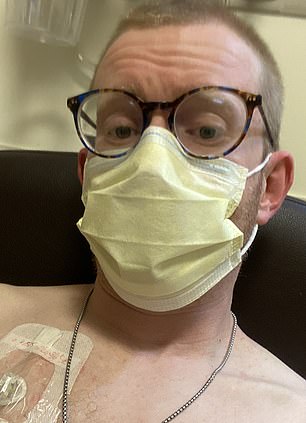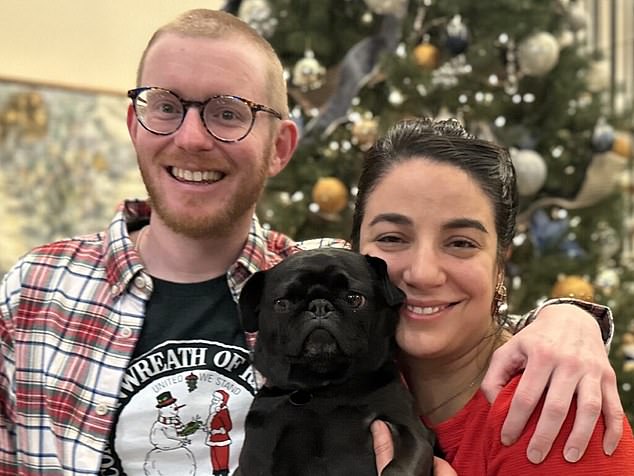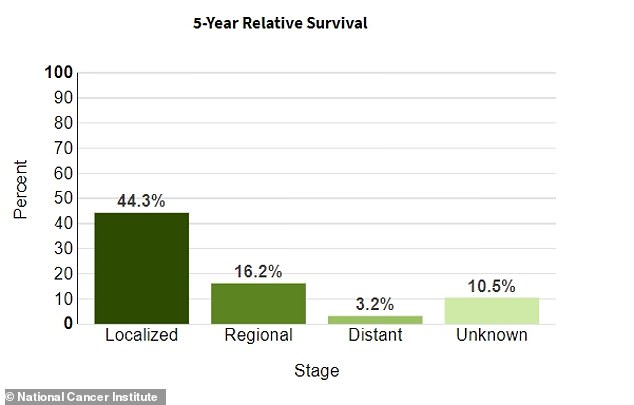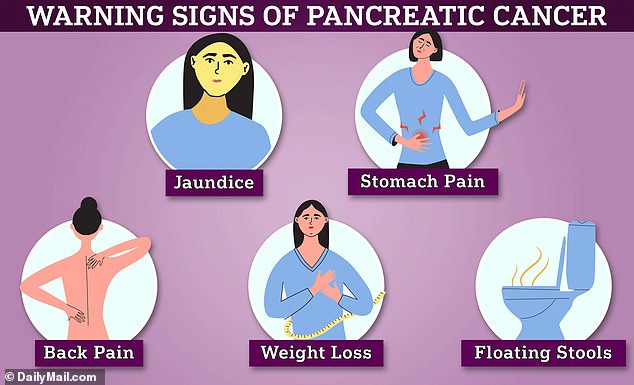How white poop was a telltale sign I had lethal pancreatic cancer… aged just 32
A Michigan man who was given a year to live after being diagnosed with deadly pancreatic cancer is still alive nearly four years later thanks to a “miracle drug combination.”
Matthew Rosenblum was just 32 years old in January 2021 when he realized he had lost weight and that his stool had turned bone white.
‘At first I thought I had a hangover. “I had a few beers the night before, so I drank some Gatorade and went to bed, but the urine wasn’t getting any lighter,” Rosenblum said. The patient story.
At the age of 25, the former PhD candidate was diagnosed with the common digestive condition Crohn’s disease, which causes inflammation in the large intestine.
Mr. Rosenblum assumed his symptoms were a result of the disease, as gastrointestinal complaints were “parcel par for me.”
However, within days his palms and the bottoms of his feet began to itch, which he described as “probably the worst” symptom. “I’ve never felt anything like that before and those are tough places to scratch,” he said.

Matthew Rosenblum, 35, was diagnosed with stage four pancreatic cancer after doctors dismissed him as ‘too young’ to have the disease. Despite the low odds, he survived for three years

Mr. Rosenblum has said that while he does not expect to live on his chemo treatment for another six years, he wants other patients to know that you are not a statistic.
‘After being itchy all night, I put my hands and feet in the bath under hot water to numb the feeling.’
He visited the hospital where emergency doctors told Mr Rosenblum that his blood was high in bilirubin – a byproduct of broken down red blood cells that affects the color of stool.
High levels can indicate a blockage in the bile duct – a tube-like structure that connects the liver to the small intestine.
Ultrasounds revealed a narrowing of this tube, which doctors tried to stretch using a stent.
Mr Rosenblum said: ‘There was no sense of urgency … they didn’t think this was something scary.’
Doctors removed the stent a few months later, after which Mr. Rosenblum’s symptoms returned. His gastroenterologist said, “I don’t know what’s going on, but you definitely don’t have cancer.”
“If you have cancer, I’ll be turning in my grave.”
However, just two hours later, Mr Rosenblum’s results showed a tumor in a part of the abdomen called the ampulla of Vater – a small opening where the pancreatic and bile ducts meet.
Mr. Rosenblum had stage four pancreatic cancer, the third-deadliest form of the disease in the US.
It has been called a ‘silent killer’ because patients rarely develop symptoms before the disease has spread to other parts of the body, where the disease is incurable.
In about 80 percent of cases, the disease is diagnosed at a late stage, when the chance of surviving longer than five years drops to three percent.

The National Cancer Institute estimates that just over 44 percent of patients with pancreatic cancer survive more than five years if the disease is still localized in the original area. It has an average survival rate of 12 percent

Early signs of pancreatic cancer include jaundice, stomach pain, back pain, weight loss and floating stools
Common symptoms include stomach pain, loss of appetite, weight loss, jaundice, dark urine, light-colored or floating stools, fatigue, and itching.
NCI estimates that 64,000 cases of pancreatic cancer were diagnosed last year, along with more than 50,000 deaths.
The majority of patients are over 65 years old and only 1.9 percent are Rosenblum’s age.
“The most popular narrative surrounding pancreatic cancer is that it is not only very deadly, but also very difficult to diagnose,” Rosenblum said.
‘The pancreas is located deep in the body. The earlier symptoms are very nuanced, can go unnoticed, and can also be misdiagnosed as a host of other things.”
‘By the time you experience symptoms, the cancer has spread beyond the pancreas. I don’t want to say it’s too late, but that’s what conventional wisdom is.”
Mr. Rosenblum would undergo a Whipple procedure, also known as a pancreaticoduodenectomy. This involves removing the head of the pancreas, part of the small intestine, part of the bile ducts, the gallbladder and some surrounding lymph nodes.
However, his surgeon said that once they opened it up, they saw that the cancer had spread to other organs, rendering it unusable.
Instead, he was prescribed a six-month course of a powerful mixture of chemotherapy drugs that were ‘terrible’ and ‘terrible’.really very abrasive’.
Mr. Rosenblum suffered debilitating nerve damage, leaving him unable to even get out of his chair.
Even worse, the medication failed to shrink the tumor.
‘At that time I had no confidence that I would be a special case or a miracle. I thought this was it,” Rosenblum said.
Doctors discovered that Mr. Rosenblum had a mutation in his BRCA2 gene, which is associated with several cancers, including breast and pancreatic cancer. This led doctors to believe that targeted therapies may help.
The oncologist told him, “You may have one to three good years with the treatment, but that’s it.”
Mr. Rosenblum received a combination of the chemo drugs gemcitabine, nab-paclitaxel and cisplatin (GAP). “My quality of life has improved dramatically,” he said.
‘By the time my first series of scans came about three months later, some of the spots on my liver had started to disappear.’
‘I haven’t lost my hair. I’m 6 feet tall. I was 215 pounds when I was diagnosed and miraculously maintained a healthy weight, so I’m very grateful for that.”
“At that point I thought I was still going to die sooner or later, so I tried to have fun and it certainly made having fun a lot easier.”
By March 2022, doctors could no longer identify any cancer beyond Rosenblum’s primary tumor. Nearly a year later, they were able to perform successful Whipple surgery and remove most of the cancer.
Rosenblum will have scans every three months for the next six years to evaluate the remaining tumor.
However, he acknowledged that although he has overcome the expectations placed on him by his doctors, “the chances of me living those six years are astronomically small.”
‘Pancreatic cancer has a remarkably low five-year survival rate. It’s unlikely I’ll see all that time, at least on paper.’
Mr. Rosenblum continues to focus on raising awareness and ensuring that other patients do not automatically view pancreatic cancer as a death sentence.
“It’s important to remember that you are not a statistic,” he said. ‘I was diagnosed with something I shouldn’t have had at my age. It was very unlikely. It was supposed to kill me, but I didn’t die, so in a sense I beat the odds not once, but twice.”
“Sometimes things get worse before they get better, and that’s no reason to lose heart.”
“Have a drink, eat the cheeseburger and live your life to the best of your ability.” That’s how I lived. Take your health seriously, but also meet yourself where you are.’
